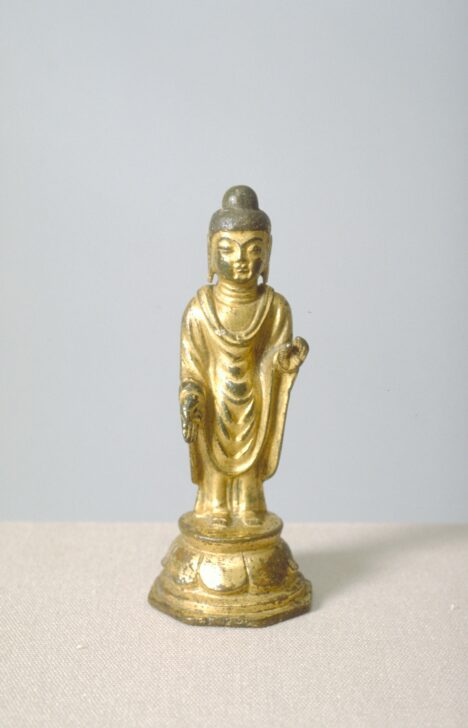Standing Buddha in Abhaya-vara mudra
Korean

Description
March 28, 2009
Silla adopted Buddhism as the state religion in the 520s, and Korean monks flocked to China, seeking sutras and images for worship. After Silla defeated Goguryeo and Baekje and unified Korea with Chinese help in 668, exchanges between the two countries increased. The ample, swelling form of the face and torso of this beautiful Buddha image reflects the sculptural influence of Tang dynasty China while following Korean aesthetics in the treatment of the facial features: square and flat face, long eye slits, and small mouth. The short body is draped in simple monastic robes worn over both shoulders, forming multiple U-shaped folds down to the knee.
Small statues like this were used for private worship in the home or taken with the owner on journeys. They originally stood alone on inverted lotus thrones or formed part of a triad with flanking bodhisattvas. The Buddha’s right hand makes the mudra (hand gesture) of abhaya, meaning “have no fear,” while his left hand makes the varada mudra, indicating “wishes are granted.”
(Label for UMMA Korean Gallery Opening Rotation, March 2009)
Subject Matter:
The Buddha, standing on a lotus pedestal, with his right hand in varada mudra ("wishes are graned") and his left hand raised in abhaya mudra (the gesture of "have no fear").
This kind of statue means the promise of Buddha to dispel the fears of sentiment beings and grant all their wishes.
Physical Description:
Gilt bronze standing Buddha on lotus pedestal. He is clothed in monastic robes with cascading U-shaped folds, similar to the gentle folds of his neck. His hands ake the form of two mudras: the abhaya (“have no fear”) mudra with the right hand, and varada (“wishes are granted”) mudra with the left.
It is well proportioned overall and represent Buddha in a standing position; a position quite popular in Unified Shilla Buddhist sculpture. The Ushinisha on the top of Buddha's head is tall, voluminous and black. The face is plump and facial features, including the eyes, nose and the mouth, are all rather small. The earlobes hang are hanging and the three curved lines on the neck are highly distinct.
The body and pedestal of this statue were cast as a single mass. The body is made of solid bronze, but the pedestal is hollow. The back part of the pedestal features a hole for the insertion of a mandorla, which is missing. Unlike most Buddha statues from Unified Silla period (676–935), the Buddha’s robes reach all the way down to the pedestal to facilitate the casting of the Buddha and pedestal as a single mass. Buddha’s left and right hands are arranged in the abhayamudrā and varadamudrā, respectively. This reverses the conventional arrangement in which the raised right hand makes the abhayamudrā dispelling fear and the left hand hung downwards makes the varadamudrā granting wishes. The plain coiffure, pedestal in the shape of an inverted lotus without the supporting part in the shape of the upward-facing lotus flower and casting technique suggest that this statue was produced during the Unified Silla period. This example has much in common with the statue excavated from Yokji-myeon, Tongyeong-si, Gyeongsangnamdo, currently housed in the National Museum of Korea. This statue was part of the collection of late James Marshall Plumer (1899–1960), a former professor of Far Eastern Art at the University of Michigan. After Dr. Plumer’s death, the statue was bought in 1961 from his widow, Caroline I. Plumer.
[Korean Collection, University of Michigan Museum of Art (2017), 216]
Usage Rights:
If you are interested in using an image for a publication, please visit https://umma.umich.edu/request-image/ for more information and to fill out the online Image Rights and Reproductions Request Form.